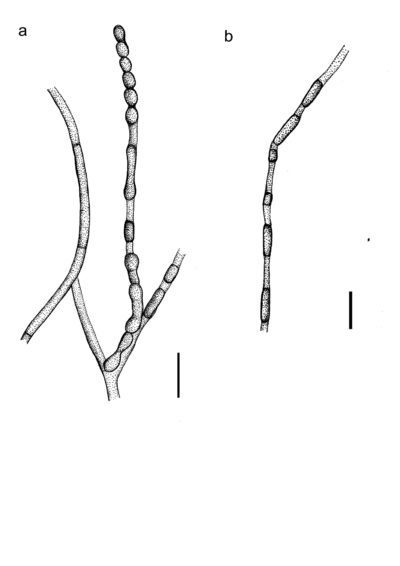Fungalpedia – Note 246, Pseudomalbranchea
Pseudomalbranchea Rodr.-Andr., Cano & Stchigel
Citation when using this entry: Thakshila et al. 2024 (in prep) – Fungalpedia, Onygenales, Eurotiales, and Verrucariales.
Index Fungorum, Facesoffungi, MycoBank, GenBank, Fig. 1.
Classification: Incertae sedis, Onygenales, Eurotiomycetidae, Eurotiomycetes, Fungi
The monotypic genus, Pseudomalbranchea was introduced by Rodríguez-Andrade (2021). This genus was typified by P. gemmata, which was isolated from human bronchial washing specimens in Florida, USA. Only an asexual state has been reported. Pseudomalbranchea has smooth, thin-walled, hyaline, and sparsely septate hyphae. Enteroarthric conidia are released from the fertile hyphae by rhexolysis and are solitary or in short chains (up to 7), one-celled, hyaline, smooth, thick-walled, and cylindrical to globose (Rodríguez-Andrade, 2021). Based on phylogenetic analyses of the ITS and LSU sequences, P. gemmate is closely related to Uncinocarpus reesii and Amauroascus volatilis-patellis. However, P. gemmate is morphologically distinct from U. reesii and A. volatilis-patellis by having longer arthroconidia and P. gemmate lacks appendages in its asexual morph compared to U. reesii and A. volatilis-patellis (Rodríguez-Andrade 2021).
Type species: Pseudomalbranchea gemmata Rodr.-Andr., Cano & Stchigel
 Figure 1 – Pseudomalbranchea gemmata (CBS 146933-ex-type culture). a, b. Arthroconidia disposed singly or in chains along the fertile hyphae. Scale bar a, b = 10 μm. Redrawn from Rodríguez-Andrade (2021).
Figure 1 – Pseudomalbranchea gemmata (CBS 146933-ex-type culture). a, b. Arthroconidia disposed singly or in chains along the fertile hyphae. Scale bar a, b = 10 μm. Redrawn from Rodríguez-Andrade (2021).
References
Entry by
Subasingha A. D. Thakshila, Center of Excellence in Fungal Research, School of Science, Mae Fah Luang University, Chiang Rai 57100, Thailand
(Edited by Chitrabhanu S. Bhunjun, Kevin D. Hyde, Samaneh Chaharmiri-Dokhaharani, & Achala R. Rathnayaka)
Published online 22 April 2024